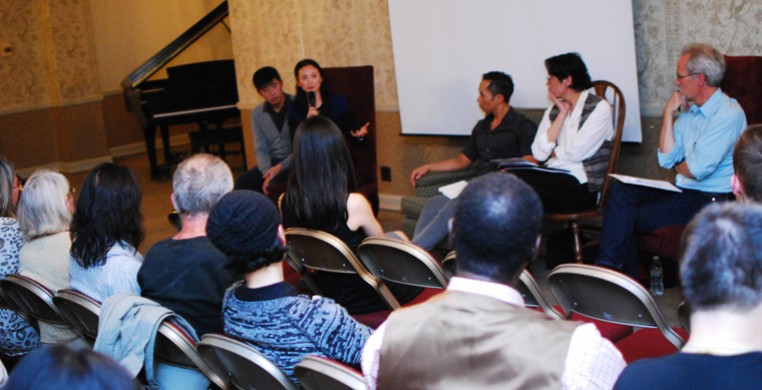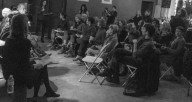By Zach Stafford
A fall breeze slipped into the room through recently opened windows while I waited, maybe not so patiently, for the “Moving Dialogs” conversation to begin. As the breeze floated around the room greeting students, dance enthusiasts, the panelists and myself, I began to think about where I was, both literally and figuratively.
Literally: I was on the South Side of Chicago at the University of Chicago, a campus who flirts with Hogwarts-like-grandeur while never letting you forget that you are actually in Chicago. Even more literally, I was in the International House, a place I hadn't been to since attending a University graduation ceremony, which took place the floor below I was sitting.
Figuratively: I was lost. Before the event I was told it was to be a conversation about Asian influences in dance. I was told I would get to hear from some incredible representatives of this topic. I was told the general questions that would be discussed at length. I was told I would need to write a reflection on what I thought about something I rarely thought about.
I was told a lot. And still, I felt lost.
I am one of those people who over prepares for everything: dates, coffee meetings, cooking, everything. The day before the event, I sat down at my desk to once again overly prep for something in my life and I had an epiphany: Don’t prepare. Just go. Thinking this made me laugh out loud. Me not prep? Who is this person talking in my head? But as I thought more about the idea, the more I liked it. Going in with a clean slate, with only my knowledge as a person of the world with what ‘Asian influences’ may mean in dance, could be interesting. Or a terrible failure.
Lucky for me it was not the latter.
***
“Asia is a big place...it’s a really big place,” Phil Reynolds , Executive Director of The Dance Center of Columbia College Chicago announced, starting the event. To his right sat H.T Chen, to his right sat Eddy Ocampo and to his right sat Wang Yuanyuan who was accompanied by a Columbia College Chicago student serving as interpreter.
Reynolds continued discussing on how Asia is in fact a large place that challenges any sort of reduction to one thing. With geographic boundaries spreading from Afghanistan to Japan’s coast, Siberian terrains to the islands of the Philippines, and more. It was quite clear that for a place with so little letters was much more vast than we like to imagine, especially in the West.
He then moved onto culture by citing puppet theater, canonical Asian stories, and other specifics within Asia that help broaden our sometimes suffocating ways to reduce such a big place. Pushing us to consider Asia being a place that defies categorization and generalization.
As Reynolds continued to expand Asia, or rather appropriately honor its expansiveness -- and I continued to feel lost and now more overwhelmed than ever -- he switched gears with a charming quickness: “I am now going to make several generalizations about Asian aesthetics in dance and performance....” contradicting his first 5 minutes.
***
Eddy Ocampo is a Filipino-American dancer and choreographer shares with the audience that when conceptualizing his work he always looks backwards. Tradition is something that as an artist, as someone with Filipino heritage, he finds to be important; it’s something he finds to be necessary.
“I identify a lot with my non-Asian friends,” Ocampo remarks as he begins to discuss what influences his work. As a writer, who is an interracial man from the South with a deep sense of personal history, I related in many ways to everything he said. I, too, identify a lot with my friends who do not identify as racial or ethnic minorities, and due to my physicality very much reading as someone who is racialized, this make my own artistic process complicated.
He continued by discussing his transnational background before jumping into naming direct influences. For him, his work must always look to tradition and see where inspiration sparks, and his job is to be a gatekeeper between what has always been and what should continue to be in regards to dance.
Taking a moment to scan the room, he pauses while sipping out of a water bottle that was only an arms length away before diving deeper the intersection of his Americanness and Filipino-ness and how folklore and tradition inform his work. And you can sense that for Ocampo, he is always thinking about Asia, or rather his relationship to an his own specific Asian heritage.
Do I focus on my blackness? Or my whiteness? Or the middle? Who, as an artist, am I speaking for? And who am I even allowed to speak for? Questions, questions and more questions.
These question were all that buzzed through my mind as I thought about Ocampo and his work. Do I focus on my blackness? Or my whiteness? Or the middle? Who, as an artist, am I speaking for? And who am I even allowed to speak for? Questions, questions and more questions. And then he said something that pushed me towards an answer, “ I always look to always bring in my part of Filipino heritage into everything I do. Filipino people see that, even with the smallest things.”
He paused again, “And they love it so much when they see it.”
When it came time for Wang Yuanyuan, she immediately began much like Reynolds by discussing the scale of China, her home country. She spoke briefly about the many provinces of the country, all of which having their own style. From her perspective, Asia is a very big place but China, itself, is independently very big and trying to reduce it seems nearly impossible. But she does see aspects worth reducing, like communication.
“Chinese people have a way of, um, talking around,” she says while using both arms to create a motion insinuating them having to go around an invisible object. Yuanyuan is trying to argue that many Chinese people have a passive way of communicating, which comes out in their dance. She references American ballet where lines are sharp and direct, reflecting cultures tied to the form. But with Chinese forms of dance, she believes their movements are passive and show that in their indirectness of motion. Their lines aren’t sharp and mimic calligraphy.
What becomes clear through Yuanyuan talking about her work and Chinese dance is the omnipresence of past, present, and even future in all things produced. For her, and the other panelist, everything contains a reference point to something before it, but you just need to know how to see it.
H.T Chen has spent his time on the panel agreeing a lot with Ocampo and Yuanyuan comments and it’s visible as he nods agreeably while interjecting frequently during many moments.
Chen is an artist with decades of work and accomplishments. His dance center, Chen Dance Center, in New York City’s Chinatown neighborhood, which is the only one of it’s kind in the area. And for the conversation, his expertise in what has influenced Asian dance has made him vital throughout the night.
When it comes time to show clips of the artists’ work Chen has chosen an excerpt from a piece titled ‘Transparent Hinge’, and for our conversation it was an amazing example of how we move from traditional to contemporary, and what that even means -- especially in our current moment of globalization.
The piece explores the history of Chinese immigrants coming through Angel Island in San Francisco. Chen shared with the audience the reasons why they used certain props to symbolize the types of labor that happened in China, before the immigrants in the show tried to migrate to America. He talked about the story he was telling and how these people, due to clerical error and accident, had their identities erased at the proverbial gates to America.
Through his discussion, I began to see Asia is a big place, but like all places it moves, it touches, it grows, and it becomes more than a place. And to my own surprise, I began to no longer feel so lost.
To discuss Asian influences in dance is to discuss people. People who lived. People are still living. And people who will come to live in the near future. This is because we are all connected, and, sure, we do need to look in the rear view window to go forward, like had been stated that night by both Chen and Ocampo, especially as artists. But I think what the conversations from this “Moving Dialogs” event showed most was we don’t always need a rear view window to see the past.
Because it is here with us informing our everyday movements, our culture, or lives in every moment. We just need to learn how to see it. And that begins with dialogue.
Zach Stafford is a regular columnist at the Chicago Tribune’s RedEye as well as The Guardian, among many other outlets. He is also the co-editor of the bestselling book, Boys, An Anthology. Follow him on Twitter at @zachstafford.


